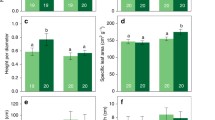Summary
Portulaca oleracea L. seedlings do not develop in the direction of neighbours, even when these neighbours are small and distant. Neighbouring plants could be simulated by small rectangles of a plastic that resembled leaves in its spectral characteristics. Unlike seedlings, mature plants did not respond to objects that do not influence photosynthetic light. When light of equal intensity was received from all directions, Portulaca seedlings avoided the direction with higher far-red light. Portulaca is thus able to use spectral composition and direction of light as clues for the probability of the direction of future shade.
Similar content being viewed by others
References
Ballaré CL, Sánchez RA, Scopel AL, Casal JJ, Ghersa CM (1987) Early detection of neighbour plants by phytochrome perception of spectral changes in reflected sunlight. Plant Cell Environ 10: 551–557
Casal JJ, Sánchez RA, Deregibus VA (1986) The effect of plant density on tillering: the involvement of R/FR ratio and the proportion of radiation intercepted per plant. Exp Environ Bot 26: 365–371
Danin A, Baker I, Baker HG (1978) Cytogeography and taxonomy of the Portulaca oleracea L. polyploid complex. Isr J Bot 27: 177–211
Deregibus VA, Sánchez RA, Casal JJ (1983) Effects of light quality on tiller production in Lolium spp. Plant Physiol 72: 900–902
Holmes MG (1983) Perception of shade. Philos Trans R Soc Lond [Biol] 303: 503–521
Holmes MG, Smith H (1977) The function of phytochrome in natural environment. Photochem Photobiol 25: 551–557
Kennedy RA, Barnes JE, Laetsch WM (1977) Photosynthesis in C4 plant tissue cultures. Plant Physiol 59: 600–603
Kasperbauer MJ (1971) Spectral distribution of light in a tobacco canopy and effects of end-of-day light quality on growth and development. Plant Physiol 47: 775–778
Kaul K, Kasperbauer MJ (1988) Row orientation effects on FR/R light ratio, growth and development of field-grown bush bean. Physiol Plant 74: 415–417
Morgan DC, Smith H (1981) Control of development in Chenopodium album L. by shadelight: the effect of light quantity (total fluence rate) and light quality (red: far-red ratio). New Phytol 88: 239–248
Sokal RR, Rohlf FJ (1981) Biometry, 2nd ed Freeman, San Francisco
Smith H (1982) Light quality, photoperception, and plant strategy. Ann Rev Plant Physiol 33: 481–518
Smith H, Morgan DC (1982) The function of phytochrome in nature. In: Shropshire Jr W, Mohr H (eds) Encyclopedia of Plant Physiology New Series, Vol 16B, 491–517 Springer, Berlin Heidelberg New York
Author information
Authors and Affiliations
Rights and permissions
About this article
Cite this article
Novoplansky, A., Cohen, D. & Sachs, T. How portulaca seedlings avoid their neighbours. Oecologia 82, 490–493 (1990). https://doi.org/10.1007/BF00319791
Received:
Accepted:
Issue Date:
DOI: https://doi.org/10.1007/BF00319791




